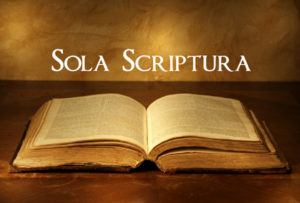 Is the Bible clear? That’s an important question. Or is it obtuse and in need of theological experts to enlighten us to its meaning?
Is the Bible clear? That’s an important question. Or is it obtuse and in need of theological experts to enlighten us to its meaning?
In the religious tradition in which I grew up, we were told that the Bible was difficult if not near impossible book to understand and it was best left up to the church theologians. It wasn’t until the conclusion of Vatican II that Catholics were freed up to read, not interpret the Bible.[1] Of course, it had to be an “approved” version such as the Douay-Rheims Bible at that time. Now there are a number of other “approved” church translations[2] that have been edited for Catholic consumption. But even now the RCC teaches that it is the Traditions of the church that interpret the Scriptures.[3] This caveat means that the Bible is not only fully authoritative on its own, but also not left up to the parishioner, the laity, to privately interpret the Bible. Therefore, the only conclusion is that for the RCC the clarity or perspicuity of the Bible is denied.[4]
But this is of course not the singular view of the RCC but of the post-modern critics of our day as well, as they deny the concept of objective truth.
But other non-Christians also raise the objection of non-clarity when they claim that “everyone has their own interpretation,” or “what about all those translations? This is, of course, obfuscation on their part and demonstrates their ignorance or more likely their bias against the Bible.
The doctrine of the clarity of the Scriptures is called “perspicuity.” By this, we mean that the Bible can be understood by people through the illumination of the Holy Spirit and that the believer is obligated to search the Scripture and judge for him or herself what it means. In short, the Bible is a plain book. This was the view of the Reformers and part and parcel of the formal argument of “Sola Scriptura” during the Reformation. Charles Hodges comments, “Protestants hold that the Bible, being addressed to the people, is sufficiently perspicuous to be understood by them, under the guidance of the Holy Spirit; and that they are entitled and bound to search the Scripture, and to judge for themselves what is its true meaning.”[5]
The Scriptures themselves claim perspicuity: [6]
- Scripture is Light – Psalm 119:105; 2 Peter 1:19
- Scripture is profitable – 2 Timothy’ 3:16-17
- The Scripture is addressed to the common people, not religious experts – Deuteronomy 6:4; Mark 12:37; Ephesians 1:1; 1Corinthinians 1:2
- Parents can teach Scripture to their children – Deuteronomy 6:6-7
- Even a child can understand Scripture’s message – 2 Timothy 3:14-15
- Scripture tests the accuracy of religious ideas – Acts 17:11
In my next post, I would like to summarize and comment on Larry D. Pettegrew’s article presented in the TMSJ 15/2 (Fall 2004). In that summary, I will limit my comments to that part of his excellent paper that highlight what perspicuity is and is not.
-Michael Holtzinger
[1] 2. “Easy access to Sacred Scripture should be provided for all the Christian faithful,” DOGMATIC CONSTITUTION ON DIVINE REVELATION, DEI VERBUM, SOLEMNLY PROMULGATED, BY HIS HOLINESS, POPE PAUL VI, ON NOVEMBER 18, 1965
[2] 25“This can be done through translations of the sacred texts, which are to be provided with the necessary and really adequate explanations so that the children of the Church may safely and profitably become conversant with the Sacred Scriptures and be penetrated with their spirit… Furthermore, editions of the Sacred Scriptures, provided with suitable footnotes, should be prepared also for the use of non-Christians and adapted to their situation. Both pastors of souls and Christians generally should see to the wise distribution of these in one way or another.” Ibid
[3] Anthony Wilhelm, Christ Among Us, A Modern Presentation of the Catholic Faith for Adults, Sixth Edition,” HarperOne, Harper Collins, 1996, pg.184
[4] Ibid pg 184-185; Also: Council of Trent (Sess.4)
[5] Charles Hodge, Systematic Theology, New York: Charles Scribner and Co., 1871, pg. 106.
[6] Larry D. Pettegrew, Professor of Theology, THE PERSPICUITY OF SCRIPTURE, TMSJ 15/2 (Fall 2004) 209-225 In his chart on “Scriptures Claims Perspicuity.”
